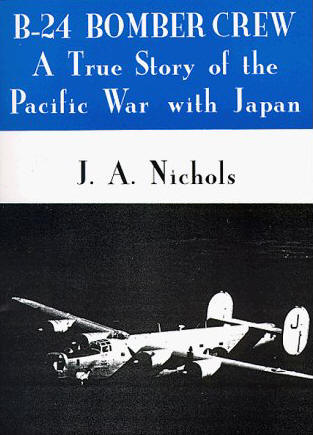A True story about the B-24 Liberator
in the war in the Pacific with Japan
The B 24 Liberator was built in a factory
called Willow Run in Detroit Michigan. The factory was built by Henry
Ford and designed by Charles Sorensen. The willow run factory was
named willow run because is it was built on the willow run creek.
This is interesting because the last person to liveon the willow run property was Warren Benjamin Kidder. I have spoken
to Ben, personally, and he is one of the nicest people that anyone could
ever meet. Ben wrote a book called Willow Run, Colossus of Industry,
a book about the production of the B-24 liberator, military bomber.
When the factory was in full production it produced a B24 liberator every
56 minutes. This factory is one of Henry Ford 's greatest achievements.
You can read more about this fantastic, very well written book by ing
here and going to the Willow Run B-24 Liberator Production Exhibit.
Book Review
"B-24 Bomber Crew" by J.A. Nichols. Subtitled: "A
True Story Of The Pacific War With Japan". Vantage Press, New York, 1997.
This small book (only 78 pages) recounts the experiences of one man in the
United Sates Army Air force in the Pacific theatre of World War II. After three
pages describing the bombed out city of Nagasaki, Japan, the story of John A.
Nichols is told in chronological order from his flight training in 1942 up to
his discharge in November 1945. There are some 19 pages of photographs (between
page 28 and page 47), so that there is a minimal amount of writing. There is the
obligatory discussion of the Depression of the 1930s, and its impact on his
family business, so that they had to move into a flat in Boston, Massachusetts.
John Nichols volunteered from Massachusetts, entered the service at Fort Devens
and went for flight training in the American South. Again, the Southerners were
still fighting the Civil War. A few pages later, Flight Engineer J.A. Nichols
begins to narrate his combat experience.
One of his more interesting combat flights involves a single B-24 Bomber making
a raid deep into Japanese held territory in order to bomb oil tanks near
Shanghai. I wish that the author had expanded more on the flight, the reasons
that a single bomber raid would be safer than many bombers and the success of
the raid. In fact, I wish he fleshed out the entire book with more details.
During the account of the Shanghai raid, the author does state that a major
difference between bombing in the Pacific and bombing in the European Theater of
Operations was the great distances covered in the Pacific. He repeats this
statement a few times. He also repeats that the crew gained "extra points" if
their plane was holed by flak. His repetitions would have been eliminated by a
good editor.
On page 26, he has a sentence fragment in the next to last paragraph. On page
27, he wanted to say, "...damaged, of course, by the
Japanese" but he wrote
"...damage of course". Since Vantage Press is a so-called "vanity publishing
house", I think that Mr. Nichols could have received more editing help on his
work. Examples above. And then, on page 56, he has a single paragraph, entitled,
"Okinawa"; this paragraph is also a single chapter that is also single page ...
leaving a lot of white space. All in all, the book is an excellent mission by
mission record of single person's World War II experiences. |


